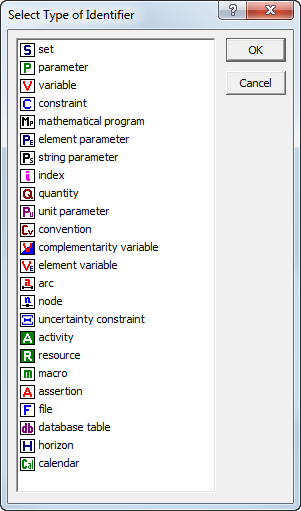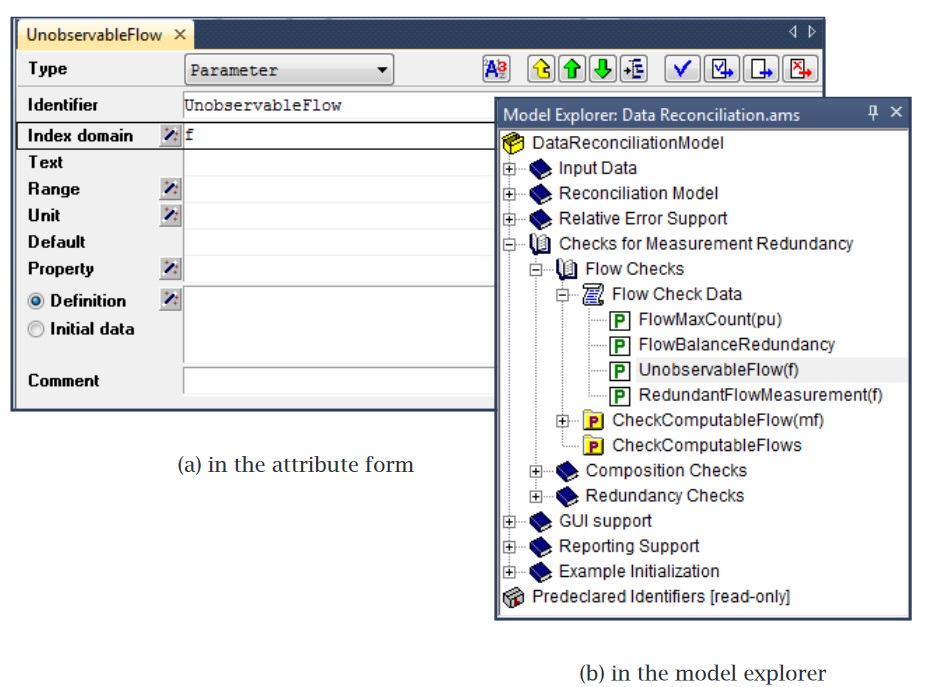Adding identifier declarations
Identifiers
Identifiers form the heart of your model. All data are stored in identifiers, and the bodies of all functions and procedures consist of statements which compute the values of one identifier based on the data associated with other identifiers.
Adding identifiers
Adding an identifier declaration to your model is as simple as adding a node of the desired type to a global declaration section (or to a declaration section local to a particular procedure or function), as explained in Working with trees. AIMMS will only allow you to add identifier declarations inside declaration sections.
Identifier types
There are many different types of identifiers. Each identifier type corresponds to a leaf node in the model tree and has its own icon, consisting of a white box containing one or more letters representing the identifier type. When you add an identifier to a declaration section of your model in the model tree, you must first select its identifier type from the dialog box as presented in Fig. 16.

Fig. 16 Choosing an identifier type
Identifier name
After you have selected the identifier type, AIMMS adds a node of the specified type to the model tree. Initially, the node name is left empty, and you have to enter a unique identifier name. If you enter a name that is an AIMMS keyword, an identifier predeclared by AIMMS itself, or an existing identifier in your model, AIMMS will warn you of this fact. By pressing the Esc key while you are entering the identifier name, the newly created node is removed from the tree.
Meaningful names are preferable
There is no strict limit to the length of an identifier name. Therefore, you are advised to use clear and meaningful names, and not to worry about either word length or the intermingling of small and capital letters. AIMMS offers special features for name completion such as Ctrl-Spacebar (see Identifier attributes), which allow you to write subsequent statements without having to retype the complete identifier names. Name completion in AIMMS is also case consistent.
Index domain
In addition, when an identifier is multidimensional, you can immediately add the index domain to the identifier name as a parenthesized list of indices that have already been declared in the model tree. Alternatively, you can provide the index domain as a separate attribute of the identifier in its attribute form. Fig. 17 illustrates the two ways in which you can enter the index domain of an identifier.

Fig. 17 Specifying an index domain
In both cases the resulting list of indices will appear in the model
tree as well as in the IndexDomain attribute of the attribute form
of that identifier. In the IndexDomain attribute it is possible,
however, to provide a further restriction to the domain of definition of
the identifier by providing one or more domain conditions (as explained
in full detail in the Language Reference). Such conditions will not
appear in the model tree.
Unrestricted order of declarations
The identifier declarations in the model tree can be used independently of the order in which they have been declared. This allows you to use an identifier anywhere in the tree. This order independence makes it possible to store identifiers where you think they should be stored logically. This is different to most other systems where the order of identifier declarations is dictated by the order in which they are used inside the model description.
Identifier scope
In general, all identifiers in an AIMMS model are known globally, unless they have been declared inside a local declaration section of a procedure or function. Such identifiers are only known inside the procedure or function in which they have been declared. When you declare a local identifier with the same name as a global identifier, references to such identifiers in the procedure or function will evaluate using the local rather than the global identifier.
Local declarations
Local identifiers declared in procedures and functions are restricted to particular types of identifier. For example, AIMMS does not allow you to declare constraints as local identifiers in a procedure or function, as these identifier types are always global. Therefore, when you try to add declarations to a declaration section somewhere in the model tree, AIMMS only lists those types of nodes that can be inserted at that position in the model tree.
Declarations via attributes
As an alternative to explicitly adding identifier nodes to the model
tree, it is sometimes possible that AIMMS will implicitly define one or
more identifiers on the basis of attribute values of other identifiers.
The most notable examples are indices and (scalar) element parameters,
which are most naturally declared along with the declaration of an index
set. These identifiers can, therefore, be specified implicitly via the
Index and Parameter attributes in the attribute form of a set.
Implicitly declared identifiers do not appear as separate nodes in the
model tree.